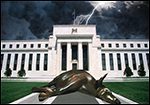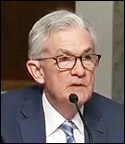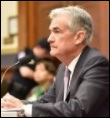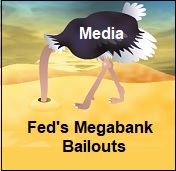-
Recent Posts
- Trump’s “Big Beautiful Bill” Is a Grotesque Giveaway to Fossil Fuel Billionaires While Adding $3.3 Trillion to Nation’s Debt
- Senator Chris Murphy Charges that Trump “Has Opened a Channel for Bribery”
- Congressman Casten: Trump’s Assault on the Rule of Law Is Causing Capital Flight Out of U.S. by Foreign Investors
- Trump’s Approval Rating Drops to 80-Year Low; IMF Says U.S. Tariffs Now Exceed the Highs During the Great Depression
- Nasdaq Has Lost More than 3,000 Points Since Trump’s First Full Day in Office in 2025; the Pain Has Barely Begun
- The Bond Crisis Last Week Was a Global No-Confidence Vote in U. S. President Donald Trump
- Trump’s Tariff Plan Guts $5 Trillion in Stock Value in Two Days; Senator Warren Calls for Emergency Action Before Markets Open on Monday
- Trump’s Attacks on Big Law, Universities, and the Media Have a Common Goal: Silence Dissent Against Authoritarian Rule
- Trump Administration Gives All Clear to Laundering Money through Shell Companies and Bribing Foreign Officials
- Four Megabanks on Wall Street Hold $3.2 Trillion in Uninsured Deposits – Which May Explain Senator Schumer’s Pivot to the GOP to Stop a Government Shutdown
- Here’s What Came Crashing Down Yesterday for Trump’s “Genius” Guy, Elon Musk: Tesla Stock, Access to Twitter (X), His Years of Secret Calls with Putin
- After Banning the Associated Press, Trump Is Now Targeting Specific Journalists That He Wants to See Fired
- Closely Watched Atlanta Fed Model Predicts Negative U.S. Growth in First Quarter
- Trump’s Gangster Diplomacy Makes Front Page Headlines Around the Globe
- Who Benefits Alongside Elon Musk If He Succeeds in Killing the CFPB: the Megabanks on Wall Street that Underwrite His Tesla Stock Offerings
- In Trump 1.0, the State Department Used Taxpayer Money to Publish a Book Elevating Elon Musk to a Superhero; It Was Funded by USAID, the Agency Musk Wants to Quickly Shut Down
- News Host Joy Reid Raises Threat of Trump Selling U.S. to Putin; Ten Days Later Her Show Is Cancelled
- Elon Musk’s DOGE Appears to Be Violating a Court Order; It Has Taken Down Hundreds of YouTube Videos that Educate Americans on How to Avoid Being Swindled
- Barron’s Releases Audio of Jamie Dimon Cursing Out His Workers at a Town Hall, as Dimon Plans to Dump Another One Million JPM Shares
- There’s One Federal Investigative Agency that Neither Trump nor Elon Musk Can Touch: It Just Opened an Investigation into DOGE
- Elon Musk’s Companies Were Under Investigation by Five Inspectors General When the Trump Administration Fired Them and Made Musk the Investigator
- Donald Trump Gives the Greenlight to Goldman Sachs and JPMorgan Chase to Return to Bribing Foreign Officials
- After Tech Geeks Built a Back Door to Loot Billions from FTX, Republicans Refuse to Investigate What Elon Musk’s Tech-Squad Did Inside the U.S. Treasury’s Payment System
- Former Prosecutor, Now U.S. Senator, Informs Tesla That CEO Musk May Be Violating Federal Law and to “Preserve All Records”
- Trump’s Hedge Fund Guy Is Now Overseeing the U.S. Treasury, IRS, OCC, U.S. Mint, FinCEN, F-SOC, and the Consumer Financial Protection Bureau
- As Elon Musk Begins Shutting Down Payments to Federal Contractors, a Strange Money Trail Emerges to His Operatives Inside the U.S. Treasury’s Payment System
- JPMorgan Chase Charged by Yet Another Internal Whistleblower with Cooking the Books
- We Asked Google’s AI Search Model, Gemini, Questions About the Fed and Wall Street Megabanks: It Got the Answers Dead Wrong
- With Trump and Melania’s Crypto Coins Likely to Raise Legal Challenges, Why Didn’t Trump Fire the SEC’s Inspector General in His Purge of IGs?
- Fossil Fuel Industry Could End Up Paying Tens of Billions for LA Wildfires and Deceiving the Public on Climate Change for Decades
- It’s Being Called the Biggest Grift by a President in U.S. History: Trump and First Lady Launch their Own Crypto Coins
- Trump Plans to Install a Fracking CEO to Head the Energy Department and Declare a National Emergency on Energy to Gain Vast Powers
- Fossil Fuel Money Played a Role in the Los Angeles Fires and the Push to Install Pete Hegseth as Secretary of Defense
- When It Comes to Wealth Retention in Retirement, Concrete May Be the New Gold
- Wall Street Watchdog Warns “Clock Is Ticking on a Coming Catastrophic Financial Crash”
- Wall Street Is Sending the Same Message to Americans on Fossil Fuel Financing that It Sent on Cigarettes: Drop Dead
- In a Six-Week Span, this Dark Pool with a Curious Past Traded 3.7 Billion Shares
- Wall Street’s Lobby Firm Hired Eugene Scalia of Gibson Dunn to Sue the Fed for Jamie Dimon
- Postmaster General Louis DeJoy Made $561,051 in Compensation in 2024, as Mail Costs Spiked and Delivery Deteriorated
- Fed Chair Jay Powell Sends a Bold Message to Trump and Tanks the Dow by 1123 Points
- The Head of Fixed Income at T. Rowe Price Makes the Scary Case for the 10-Year Treasury to Spike to 6 Percent
- $663 Billion in Cash Assets Have Gone Poof at the Largest U.S. Banks
- Donald Trump to Ring Bell at New York Stock Exchange Today as Hit List Posters Appear in Manhattan Targeting Wall Street CEOs
- Trump Has a Slush Fund to Prop Up the Dollar – Will He Use It to Prop Up Bitcoin Instead?
- A CEO Assassination; a Billionaire Heiress/NYPD Commissioner; a Secret Wall Street Spy Center – Here’s How They’re Connected
- Despite More than 1600 Tech Scientists Signing a Letter Calling Crypto a Sham, Trump Names a Crypto Cheerleader for SEC Chair
- The Fed Rings a Warning Bell: Hedge Funds and Life Insurers Are Reporting Historic Leverage
- Trump’s Nominee for FBI Director, Kash Patel, Has Businesses Financially Intertwined with Trump
- Donald Trump Is at Risk of Getting Named in a Fossil Fuels Conspiracy Lawsuit
- Trump Is Having Difficulty Getting a Lawyer to Accept the Nomination for SEC Chair: Here’s Why
Search Results for: Federal Reserve
Biden Has Nominated a Man from the Sandy Weill/Robert Rubin/Tim Geithner School of Wall Street Hubris to Head Regulation at the Fed

By Pam Martens and Russ Martens: April 20, 2022 ~ In addition to being a law professor at the University of Michigan, Michael Barr also holds the title as the “Joan and Sanford Weill Dean of Public Policy at the University of Michigan’s Gerald R. Ford School of Public Policy.” The Ford School sits in a building called the Joan and Sanford Weill Hall, which was given that name as the result of a $5 million donation from the Weills. To anyone who hasn’t been in a coma since the Wall Street crash of 2008 – an event that sent the U.S. economy into the worst economic collapse since the Great Depression – an affiliation with the name “Weill” should have been an automatic disqualifier for any position in the Biden administration even remotely connected to regulating Wall Street. Instead, at the behest of some powerful person or persons, Michael Barr … Continue reading
Why Didn’t Vanguard, the Largest Mutual Fund Family in the U.S., Need to Borrow from the Fed while the Wall Street Titans Did?

By Pam Martens and Russ Martens: April 19, 2022 ~ For the past week, Wall Street On Parade has been crunching the cryptic data released by the Federal Reserve on March 31 that named the mutual funds that couldn’t meet redemption requests in their money market funds in March and April of 2020 without tapping loans from the Fed. As we reported yesterday, the Fed loaned a cumulative total of $162.9 billion from its Money Market Mutual Fund Liquidity Facility (MMLF) in March and April of 2020 with 72 percent of that total going to just six mutual fund families: Federated $27.75 billion; JPMorgan $24.8 billion; Morgan Stanley $19.55 billion; UBS $17.3 billion; Wells Fargo $15.5 billion; and BlackRock $11.98 billion. There are two striking aspects to this story. First, no mainstream media outlet will go near the story. The same media outlets that battled the Fed in court for more … Continue reading
Just Six Wall Street Firms Borrowed $116.83 Billion from the Fed’s Money Market Bailout Fund – 72 Percent of the Total

By Pam Martens and Russ Martens: April 18, 2022 ~ The Federal Reserve has set up a veritable obstacle course to prevent the public from drilling down to see that just six big Wall Street firms received the lion’s share of loans from its emergency funding facility called the Money Market Mutual Fund Liquidity Facility (MMLF). The MMLF made emergency loans from March 23, 2020 through April 23, 2020, but the program did not end on April 23, 2020. That’s because these were not overnight loans. They were loans made for periods up to as long as 11 months in some cases – taking the program into 2021. The MMLF made loans against paper that could not be sold elsewhere that was sitting in money market funds that were having difficulty raising cash to meet redemption requests. The loans were for the same maturity as the paper being put up … Continue reading
Here’s a List of Toxic Assets that Blew Up in Money Market Funds at Goldman Sachs, JPMorgan, Morgan Stanley and Others that the Fed Bailed Out

By Pam Martens and Russ Martens: April 13, 2022 ~ On March 31, the Federal Reserve finally released a trove of secret transaction data revealing which Wall Street trading houses had to borrow hundreds of billions of dollars from a panoply of Fed bailout programs. One of those bailout programs was the Fed’s Money Market Mutual Fund Liquidity Facility (MMLF) which bought paper residing in the money market funds of large Wall Street firms that no one else on the street wanted to buy – or at least at a price that would prevent staggering losses for the funds, which are supposed to trade at a stable $1 per share price. We have begun to unravel the cryptic details of the MMLF, although the Boston Fed which administered the program for the Federal Reserve used a bag of tricks to make that process as difficult as possible for journalists. For example, … Continue reading
Fed Governor Lael Brainard Should Not Be Leaking Details of Fed FOMC Minutes, Especially Given Her Husband’s Ties

By Pam Martens and Russ Martens: April 12, 2022 ~ Multiple current and former Federal Reserve officials remain under investigation for the worst trading scandal in Fed history. This investigation includes the former President of the Dallas Fed, Robert Kaplan, who traded in and out of S&P 500 futures contracts in lots of “over $1 million” while sitting as a voting member of the Fed’s Open Market Committee (FOMC), which sets interest rates and makes other critical monetary policy decisions that move markets. The investigation also involves former Boston Fed President Eric Rosengren, who actively traded in a joint account with his wife, who had been given a margin account by a Fed supervised bank, Citigroup’s Citibank. (See our extensive archive on the Fed’s trading scandal.) Last Tuesday, President Biden’s nominee for Fed Vice Chair, Lael Brainard, who has been a Fed Governor since 2014 and has had a permanent voting … Continue reading
News Blackout: On the First Day of the Fed’s Money Market Fund Bailouts, JPMorgan Funds Borrowed $8.97 Billion – 32 Percent of the Total

By Pam Martens and Russ Martens: April 11, 2022 ~ On Thursday, March 31, the Federal Reserve released the names of the Wall Street trading houses and the amounts they had borrowed under three of the Fed’s emergency bailout programs. The data included the Fed’s repo loans for the first quarter of 2020 — the Fed is releasing the repo loan information after a two-year lag on a quarter-by-quarter basis, thus obfuscating a clear snapshot for the life of the program; the Fed’s Primary Dealer Credit Facility (PDCF); and the Fed’s Money Market Mutual Fund Liquidity Facility (MMLF). The Fed also released on March 31 the transaction details for its Commercial Paper Funding Facility but that essentially just showed which commercial paper had become toxic on Wall Street while the other three programs illustrated which units of the mega global banks had become illiquid and needed Fed bailouts stretching over many … Continue reading
These Charts Show How the Fed’s Secrecy Has Killed the Price Discovery Function of the Stock Market

By Pam Martens and Russ Martens: April 6, 2022 ~ As the chart above indicates, from March 20, 2020 through May 12, 2021 the share prices of the French global bank BNP Paribas, the Canadian global bank, Royal Bank of Canada, and the German global bank, Deutsche Bank, were surging in value. But unbeknown to the marketplace, thanks to a dark curtain the Federal Reserve of the United States drew tightly around one of its secret loan programs, the trading units of these three foreign global banks were being propped up with vast sums of cheap loans during that span of time by the Fed. The secret loan program was the Primary Dealer Credit Facility (PDCF) – the same program the Fed used during and after the Wall Street collapse in 2008 to funnel $8.9 trillion in cumulative loans to foreign and domestic trading houses and banks, according to an audit … Continue reading
New Data Shows Fed Chair Powell Misled Congress on the Condition of the Megabanks and their Need for Emergency Loans

By Pam Martens and Russ Martens: April 5, 2022 ~ Throughout 2020, Fed Chair Jerome Powell repeatedly testified to Congress that the banks in the U.S. had proven to be a “source of strength” during the pandemic. Last Thursday the Fed released the names of the banks and dollar amounts they had needed to borrow under some of the Fed’s emergency loan operations. The data showed that units of two of the largest depository banks in the country, JPMorgan Chase and Citigroup, had required vast sums from the Fed’s emergency repo loan operations as well as its Primary Dealer Credit Facility (PDCF). In the Fed’s first report to Congress on its Primary Dealer Credit Facility which provided a dollar amount outstanding, the Fed reported that “the total outstanding amount” as of April 14, 2020 was $34.5 billion. The PDCF was announced on March 17, 2020 and began making loans on March … Continue reading
In a Six-Day Span in March 2020, the Dow Crashed 5,676 Points; the Fed Responded with Almost $1 Trillion in Repo Loans to 24 Trading Houses

By Pam Martens and Russ Martens: April 4, 2022 ~ The Federal Reserve, the central bank of the United States, has a “dual mandate” to target inflation and to maintain “maximum sustainable employment.” The Fed has zero mandate to target a specified level for the Dow Jones Industrial Average or to prevent stock market crashes by printing money out of thin air and pumping it out to the trading houses on Wall Street. But under Fed Chair Ben Bernanke during the Wall Street crisis in 2008 and Fed Chair Jerome Powell in 2019-2020, that’s exactly what the Fed decided to do. The majority of the stock market is owned by the wealthiest 10 percent of Americans. Thus, when the stock market is bailed out by the Fed, which we can now show overtly occurred from March 9 through March 16 of 2020, the Fed is effectively bailing out the rich. The … Continue reading
The Fed’s Secret Repo Loans, another News Blackout, and a French Bank Scandal

By Pam Martens and Russ Martens: March 31, 2022 ~ As thousands of businesses were forced to close in the U.S. as a result of the coronavirus outbreak in March of 2020, and millions of Americans were financially struggling, the Federal Reserve was pumping what would become a cumulative $3.84 trillion in secret repo loans into the U.S. trading unit of the giant French global bank, BNP Paribas, in the first quarter of 2020. The repo loan market is where banks, brokerage firms, mutual funds and others make loans to each other against safe collateral, typically Treasury securities. Repo stands for “repurchase agreement.” The Fed only comes to the rescue of this market when there is a liquidity crisis and Wall Street firms are backing away from lending to each other. September 17, 2019 was the first time the Fed had to intervene in the repo market since the financial crisis … Continue reading

